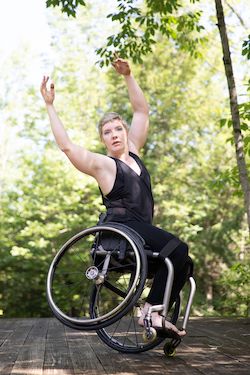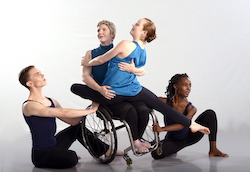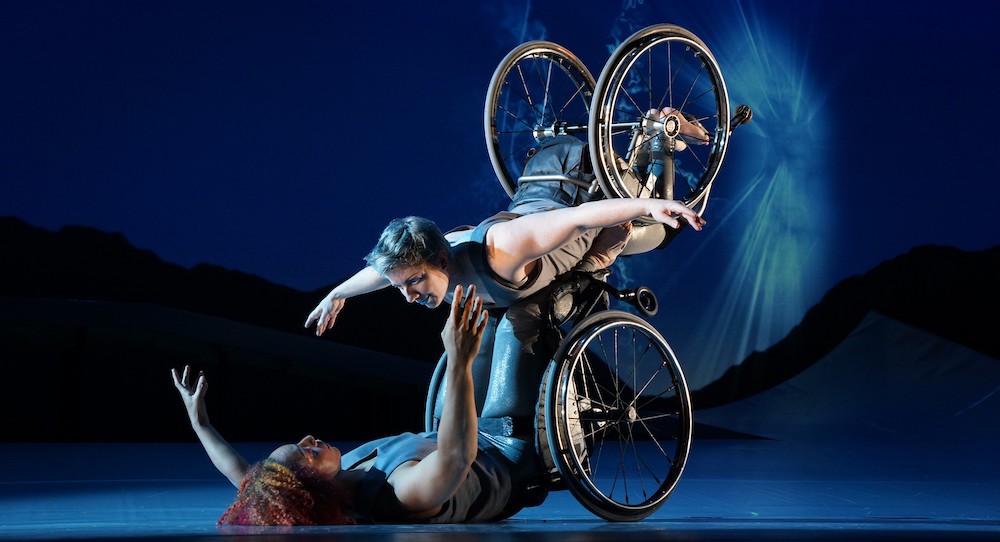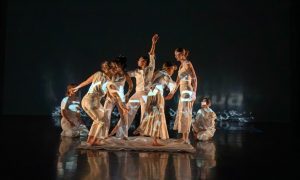Laurel Lawson, an Atlanta-based activist, disability arts leader, dancer and technologist recently received an inaugural Dance/USA Artist Fellowship. The select group includes 31 artists, and Lawson is the only recipient from the southeast. Dance Informa caught Lawson between rehearsals to learn more about the award, what inspires her commitment to being a disability arts innovator and the projects that excite her right now.
Dance/USA Fellowships to Artists (DFA) provides direct support to dance artists who work through dance to address social change within one or more communities. What are some of your plans or big ideas, and do you anticipate audiences will be able to see your work?
“I’m planning to continue the work I’ve been doing specifically with technique for disabled dancers and extend my explorations into ways tech platforms can augment and amplify artists and create new kinds of access and ways of connecting for and with audiences and communities.
On stage, audiences can see my work with Kinetic Light in various east coast venues this fall, including Miami, Atlanta and Vermont. I also have a commission premiering in Cleveland in June, and am looking forward to more opportunities to make work. My current choreographic interests live in the connection between my long-term love of myth and folklore and where we find disability, queerness and gender living in those stories.”
What was the DFA application process like?

Laurel Lawson at Jacob’s Pillow. Photo by Hayim Heron, courtesy of Jacob’s Pillow.
“One of the requirements of this fellowship is that artists have been involved in an artistic practice which is in conversation with social change for a minimum of seven years; so in addition to the more usual narratives and work samples, there was a focus on artists’ communities and work history. It was a lengthy process culminating in an intensive in-person panel review.”
Atlanta-area audiences especially recognize you as a long-time member of Full Radius Dance and may also know you from your acclaimed role with the artist collective known as Kinetic Light. How does being a Dance/USA Fellow help you build relationships to further the social, political and creative missions of all the organizations with which you have affiliation?
“Being part of two companies and working independently means I have a very complicated schedule, but it does also mean I have a lot of options when it comes to making those connections. Full Radius Dance and Kinetic Light are completely different kinds of companies, with totally different and complementary programs and allied artistic, social and political viewpoints. I tend to network by nature; I love making the right connections between the right people, whether in my immediate circle or not.”
When and how did you begin your dance training and eventual career?
“While I had extensive training and professional experience in music and theater, as well as a background in elite athletics, I did not begin training in dance until after undergrad. I began taking classes with Douglas Scott, the artistic director of Full Radius Dance, and was eventually invited to audition for the company.”
What can readers do to help promote the genre of disability art? How does a person who wants to begin training find a location to get started?
“Support disabled artists. Go see their work; talk about it, write about it, donate to it. Treat the work just as you would any other performance. You’ll love some, dislike others. Don’t imagine that once you’ve seen one company you’ve seen everyone; unless of course you’d say that Pacific Northwest Ballet, Alvin Ailey American Dance Theater and Sean Dorsey Dance all look the same!
One of the major challenges here is that our granting system largely requires that you present proof of accomplishment as well as proof of organizational capacity before you can be funded, so if you’re not coming through a traditional support system like a degree program or a conventional company, you can’t bootstrap yourself into the funding or presentation system. Access to training and development pathways is one of the largest problems for disabled artists, and we need funders to jump in and work with us. How do we create support earlier and in a useful way?
Right now, it’s very challenging to train toward a professional career unless you are in a position to take an apprenticeship with one of the established companies. Access to teachers with specific experience with both disabled and physically integrated technique is crucial. The consistent, intense, high-frequency training required to make a dancer makes it difficult to pursue other full-time work. At Full Radius Dance, we take in and train disabled apprentices; however, at this time we don’t have funding support to offer apprentice stipends so that people can focus on their training. That’s where I would really love for a funder to commit with us so that we can offer more opportunities to people with the talent and desire and drive to become dancers.”
Kinetic Light artist collective’s signature work, DESCENT, has received a lot of attention and accolades. Please briefly describe this work and its impact on your creative journey.
“DESCENT has been a significant journey for me and all the artists of Kinetic Light. It was our first collaboration; for [Kinetic Light founder] Alice [Sheppard] and I, it was our first evening-length work, and over the year-plus of creation and reworking and refining to bring it to premiere, we all learned a great deal.
Most people start with the ramp; DESCENT takes place on a stage-size ramped landscape. We had to create new ways of moving to work with this landscape and its demands. A substantial amount of the choreography is about bringing out the conversation between the ramp and our body, whether wheeled or on the floor. Beyond the ramp, however, DESCENT is a story told in light by the third member of Kinetic Light, Michael Maag. On one level, Alice and I dance the relationship of Venus and Andromeda, and Michael not only expands the story beyond our bodies into the ramp and the sky, but tells a complex story with supporting characters. The integration of the lighting, projection, set, sound, costume and wheelchair design is why Kinetic Light and DESCENT was selected by the USITT to be featured at the Prague Quadrennial, the largest performance design event in the world, running this June 6-16. All of these elements come together with the movement performance to create an experience inviting the audience into the mythopoeic world we’ve created, and the tender and tempestuous story of Venus and Andromeda.
As my first experience with a full-length narrative, character-driven work, I suspect I learned more as a performer than in the previous five years of work, and I’m deeply grateful to all the people who made this journey with us. It would not have been possible without the Kinetic Light team, all the funders and supporters who gave generously of their expertise and experience and connections, and the other artists, designers and technicians all over the country who made various parts of this with us.”
Is there occasion for the 31 Dance/USA Artist Fellows to meet, and do you see any possible collaborations coming from within the group?

Full Radius Dance. Photo by Neil Dent.
“One explicit requirement of the fellowship is that we meet at the beginning and end of the fellowship period, coinciding with the Dance/USA annual conference. I can’t speak to any collaborations within the group as yet, but I can say that it’s an incredible group of artists, and I’m looking forward to being locked up for two days in June with all of them. As an artist, I love collaborating and I’m open to opportunities, so I’m also interested in what this fellowship might enable beyond the immediate cohort.”
What is Audimance? How did you and Kinetic Light create it, and how do you incorporate it into your work? What additional uses do you see for this groundbreaking technology?
“Audimance began as our solution for our blind and visually impaired audience. The previous state of the art in dance was single-stream audio description, where a live describer sits in the audience or the booth and gives an oral interpretation of the show which can be accessed via headset. Dance describers are unfortunately few and far between; it’s an art in and of itself that takes extensive training, and it has the limitation of being one person’s interpretation of what’s going on. Each describer has their own style, whether factual (think of a technical or literal description of the movement), scenic, emotional or attempting to interpret story. Any given describer’s style may well not align with audience preference; not to mention that any one person can’t process or speak fast enough to say everything that’s happening in even a minute of dance! Our community told us that they could tell what was on stage was far more complex than what they were experiencing. Equity is a core value of Kinetic Light, both for artists and audiences who choose our experience.
Audimance is not about replacing audio description but about blowing it open. Centering blind and visually impaired audience members, it allows choice and agency in their experience. It’s a way we can provide multiple styles of description, including things like poetry, screenplays, technical prose, soundscapes, even live microphones from the stage; audience members choose what tracks to listen to, how many, and you can move between sources on the fly as if you were in a room and moving closer to a speaker playing something you wanted to hear. Guided by our audiences, friends and colleagues, I created the original design, and CyCore Systems wrote the platform. It is open source, and we are seeking funding to research and write the public creation interface and tutorials so that other artists and venues can use it.
We set out to create a more equitable means of access and wound up creating a whole new art form. The key here is equity: diversity might keep you from screwing up too badly, inclusion might mean you actually consider how people who don’t look like you will use something, but equity is the fastest and most powerful route to true innovation. Every creative team in every field needs to understand that.
Audimance will be useful for any type of performing art, whether at the minimal level of single-stream, traditional audio description (which can then be available for any performance, not just the usual one or none that feature a live describer), or the kind of complex multi-layered content which we are researching and executing at Kinetic Light. It is also a platform for independent durational sonic artwork, and I’m excited about beginning work with other artists who are interested in exploring the possibilities of the platform.”
What are some of your fitness and health routines, and what do you do for fun?
“In addition to dance, I’m a member of the USA Women’s Sled Hockey team. When I’m in Atlanta, I train before class or rehearsal most days. Ice hockey is a power sport; you’re essentially sprinting in 90-seconds on/180-seconds off intervals for an entire game, so it requires a very high level of conditioning on a year-round basis. It works well for me to go straight from the gym to class because I’m already completely warm and able to use class time to really focus in on technique.
During residencies and touring, of course, training, rest and nutrition can require a lot of creativity. Since I’m consistently in training and/or rehearsal at least six days a week, recovery is very important the rest of the time; but when I have time off, I enjoy camping, paddling, cooking and cuddling my dog.”
By Emily Yewell Volin of Dance Informa.















